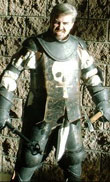|
|
This topic comprises 5 pages: 1 2 3 4 5
|
|
Author
|
Topic: Change lens turret to Flat in between EVERY show?
|
Jesse Skeen
Phenomenal Film Handler

Posts: 1517
From: Sacramento, CA
Registered: Aug 2000
|
 posted 07-20-2001 08:42 AM
posted 07-20-2001 08:42 AM




OK, I gots a problem, tell me I'm wrong here:
I've basically been ordered to have all projectors showing scope films to automatically switch the lens, apertures and masking to Flat at the end of every show, and switch everything back to Scope when "Start" is pressed. The main reason for this being they want the intermission slides shown on the full-size flat screen, which I won't argue with, but also because the scope lenses are the large kind and opening the turret will bang them against the projector- I checked this and found only two that actually touch the projector when open, the rest come a bit close but do not make any contact. I usually thread with the turrets closed anyway and have told others to be extremely gentle with them; I would think that wear and tear on the motors would be a lot worse than any possible damage from the lens being close to the projector, plus the aperture gets moved back and forth when it doesn't need to.
ALSO, and this is a BIG one, as I'm VERY particular about this- the lens and aperture do NOT always fall perfectly back into place- adjusting the turret up and down by hand is usually necessary when a lens is changed as it won't be perfectly centered on screen. It's usually just a hair of black at the top or bottom which some would call being 'too picky', but it's just not right to show a film without the picture PERFECTLY centered. Usually Thursday nights when films change I run light on the screen just to make sure the lens and aperture are perfectly centered, and if they get to stay that way the whole time the film is on that screen then there's no problem. Of course if the automation has to switch them every show, this goes completely out the window. (Yes, I've used the allen wrenches to horizontally and vertically align the lenses- the motor still won't always put them back in the exact same place every time without having to adjust by hand.)
When we were told to do this, I went along with it to see how it went. The first day someone else worked up there under this new arrangement, one of the apertures did not get pushed back fully into place and they had to call me to ask how to adjust it. When I came in after someone else's shift, I found several screens with the lens aimed either too high or too low, one where the automation didn't even move the masking up even though it was set to do it, and when it came time for me to start shows I had a few start with the picture almost on the ceiling because the motor couldn't move the lens back fast enough! After that I gave up and had everything like it was before, but I've basically been ordered to go back to having it change so I really can't disobey that.
I would think the sensible thing to do would be to change the automation so that ONLY the masking is adjusted between shows, but our technician says the lens has to move too to avoid hitting the projector and everyone else is respecting that.
Does anyone here think this makes sense? I've never heard of doing this in the 9 years I've been working in projection booths and this really seems to have a lot more negatives than positives going for it. This is going to mean I will have to 'tweak' the lenses on just about EVERY show to get them right, and the other people running the booth who have only a few months experience will have one more thing to worry about which I feel is unnecessary. Any thoughts from others here would help a lot- and if you think my opinion on this is wrong, I'll just shut up.
| IP: Logged
|
|
Jerry Chase
Phenomenal Film Handler

Posts: 1068
From: Margate, FL, USA
Registered: Nov 2000
|
 posted 07-20-2001 09:26 AM
posted 07-20-2001 09:26 AM




LOL, referring to a different thread, if you don't like the policies set by the company, you can always leave...  Seriously, I would try to find out who gave the original order and why. Have lenses been damaged at other theatres or at your theatre because of opening the turret while in scope? A couple of broken lenses usually make at least one person in corporate sit up and ask why. The problem, it would seem, is that your turrets and plates aren't locking into place properly. Is this something that can be fixed? The same person who had the idea of changing position every show might be interested in getting constant reports of "film started showing on ceiling, turret malfunctioning." Communication and documentation are key issues. In a responsive situation, a few of these would get your turrets repaired or replaced. In a non-responsive situation, it might get the technician to start agreeing with you that the lenses should be left in place. Otherwise, he'll be hard pressed to explain why he can't fix the things and upset that he has to keep coming out to try.
| IP: Logged
|
|
Evans A Criswell
Phenomenal Film Handler

Posts: 1579
From: Huntsville, AL, USA
Registered: Mar 2000
|
 posted 07-20-2001 10:03 AM
posted 07-20-2001 10:03 AM





There is one theatre in my area that has everything be set for flat at the beginning of the show. Scope films are always shown with a flat "fire marshall" trailer, and usually a few assorted flat trailers, then a scope changeover is done and at the end of the movie, it changes back to flat. I have not noticed inconsistent alignments on repeat visits to auditoriums in this theatre. In fact, the alignment seems remarkably consistent from show to show. This theatre uses Christie projectors.All other theatres typically set everything up for flat or scope beforehand and run everything at one setting. I'd say if Carmike 10 has been making the change between every show for scope films and has not had any major alignment problems as a result (since March 5, 1998), either they're constantly readjusting, or the practice isn't causing alignment drift. I thought about this back in 1998 and asked Clayton Snell, then the manager of Carmike 10, and calculated the number of times per week that the turret, aperutre plate, and masking would have to move per week compared to just once per week (at most) the other way. I don't remember his exact response, but he indicated that it did no harm. I had another manager of another theatre, while he was showing me how an aperture plate mechanism worked, say that it was good for the mechanisms to get moved frequently. It's an interesting issue.
------------------
Evans A Criswell
Huntsville-Decatur Movie Theatre Info Site
| IP: Logged
|
|
John Walsh
Film God

Posts: 2490
From: Connecticut, USA, Earth, Milky Way
Registered: Oct 1999
|
 posted 07-20-2001 12:22 PM
posted 07-20-2001 12:22 PM




I definitely agree with Jerry; The turrets and aperture plates should be working correctly. I feel thatís more important than this flat/scope issue. Itís great that you adjust them when starting, but you canít work every single shift! You didnít say what kind of projectors and turrets you have. Iíve never seen where even an anamorphic lens contacted the projector. Perhaps you can put a rubber bumper (or equiv) somewhere to keep it from hitting. Many automations are designed to automatically return the lens and masking to flat at the end of the show, or when powering up the equipment. I guess yours does not. What kind of automation? As far as the wear on the aperture or turret motor, I think it would be minimal. Iíve got eight projectors with turrets. For the first six years, we changed formats on the fly, and I think two went bad in the whole time. Trailers are available in both formats now; we no longer cue from one to another while running. If the feature is flat, we get all flat trailers, etc.
| IP: Logged
|
|
|
|
|
|
|
|
Brad Miller
Administrator

Posts: 17775
From: Plano, TX (36.2 miles NW of Rockwall)
Registered: May 99
|
 posted 07-20-2001 03:12 PM
posted 07-20-2001 03:12 PM




Not to sugar-coat this, Val Morgan is my experience is the anti-Christ of slide shows. This company demands bs like this as well as other equally assinine policies such as having the house lights almost all the way down during their slide shows. (The "half light" for previews wasn't even enough to make them happy, they ordered it to be dimmed further and prohibited "full up". Yes, our customer's safety climbing stadium seating can be damned.) On top of that, they wouldn't allow us to run the slide lamp on full brightness and insisted we run it on the dim setting. This was because slide projector bulbs were too expensive for them. One lady actually said we needed to "dim the movie projectors to match the brightness of their slide show"! They did not provide us with any support on repairing the projectors and the personnel were very rude. I remember one day getting a lecture about how it was our responsibility to calibrate the speed controls on the projectors. This lady had a STOPWATCH and was furious because she found a projector that was changing .2 seconds late. (She is very lucky I did not further dent up a Technicolor can with her head.) I could go on and on. I have nothing nice to say about that company. They give on-screen advertising a bad name. Jesse, it IS Val Morgan, isn't it?
| IP: Logged
|
|
|
|
|
|
|
|
|
|
|
|
Jesse Skeen
Phenomenal Film Handler

Posts: 1517
From: Sacramento, CA
Registered: Aug 2000
|
 posted 07-20-2001 04:45 PM
posted 07-20-2001 04:45 PM




Yes to both questions. When I was first asked to do this I called CSM and asked if we were in fact required to raise the masking for their slides, and the person I asked didn't even understand what I was talking about! A manager says that it is in the advertisers' contract that this be done though, so I'm in no place to argue with it, though I will say I find it distasteful to have the masking change at any time the audience can see it, particularly if it's top/bottom masking. The masking in this theater is made of the same cloth as the rest of the auditoriums and blends in very well, so at first glance you can't even tell it's there. In many auditoriums the house lights drown out the slides too much; some actually are a lot more readable when centered on a screen masked for scope than they are when brought all the way out for flat because the lights shine in the corners.
I haven't been too impressed with this slide presentation though; there are a LOT of outdated slides, a few almost 2 years outdated (one advertises an offer that expired sometime in 1999), another advertises a "Winter Special" even though it's the middle of July, and there are some Christmas-themed slides still up promoting gift certificates. I've been told that we at the theater are not responsible for this however, people from CSM come in and change them though they never seem to do it when I'm there so I can ask if they know they have so many outdated slides. They are the only people who can bring us slide projector bulbs too, and they have been slow in that department- we once had five projectors out for a week because we had run out of bulbs, I called them and let them know, and they ended up sending the wrong size bulbs, so I had to call them back, and finally they brought enough to replace the ones that were out but not enough spares so now others are going out with nothing to replace them.
When I started working at this theater, most of the slides were unreadable in one corner because the reflector portion of the slide projector had a lot of dust built-up on it; I cleaned all of those and do so on a regular basis now.
As I said though, I'm not in a position to argue with how the slides are presented, my concern here is that having the lens and apertures move is going to compromise the film presentation- most of the lenses move 'in the ballpark' but as I said I will not settle for them not being PERFECTLY centered. When this theater opened they were running flat trailers on scope films and cuing the lenses to change, but they stopped because it didn't always work.
| IP: Logged
|
|
Brad Miller
Administrator

Posts: 17775
From: Plano, TX (36.2 miles NW of Rockwall)
Registered: May 99
|
 posted 07-20-2001 04:55 PM
posted 07-20-2001 04:55 PM




Jesse, I see no reason why you cannot intercept the automation from changing the lens/aperture, but make sure you put some sort of switch so you CAN switch formats without physically forcing the lenses.By the way, you never said what kind of automation and projectors you are using. On the house light issue, I pointed this out to the theater that was running the evil Val Morgan shows, but apparently this easy solution was too difficult to comprehend. As I found out, removing just ONE house light bulb was all it took to prevent the light from shining on the screen during the slides (washing them out). We're talking one bulb out of perhaps 30. This would have been the safer alternative for the patrons to keep from falling in those stadium auditoriums, but to hell with their safety, right? Right!  Anyway, before you go dimming the lights during the slides you might want to take a look at which particular bulbs are shining onto the screen. You may be in that same situation and just perhaps, the corporate people may have a few more brain cells at your theater. Anyway, before you go dimming the lights during the slides you might want to take a look at which particular bulbs are shining onto the screen. You may be in that same situation and just perhaps, the corporate people may have a few more brain cells at your theater.
| IP: Logged
|
|
|
|
All times are Central (GMT -6:00)
|
This topic comprises 5 pages: 1 2 3 4 5
|
Powered by Infopop Corporation
UBB.classicTM
6.3.1.2
The Film-Tech Forums are designed for various members related to the cinema industry to express their opinions, viewpoints and testimonials on various products, services and events based upon speculation, personal knowledge and factual information through use, therefore all views represented here allow no liability upon the publishers of this web site and the owners of said views assume no liability for any ill will resulting from these postings. The posts made here are for educational as well as entertainment purposes and as such anyone viewing this portion of the website must accept these views as statements of the author of that opinion
and agrees to release the authors from any and all liability.
|

 Home
Home
 Products
Products
 Store
Store
 Forum
Forum
 Warehouse
Warehouse
 Contact Us
Contact Us




 Printer-friendly view of this topic
Printer-friendly view of this topic















 Anyway, before you go dimming the lights during the slides you might want to take a look at which particular bulbs are shining onto the screen. You may be in that same situation and just perhaps, the corporate people may have a few more brain cells at your theater.
Anyway, before you go dimming the lights during the slides you might want to take a look at which particular bulbs are shining onto the screen. You may be in that same situation and just perhaps, the corporate people may have a few more brain cells at your theater.



